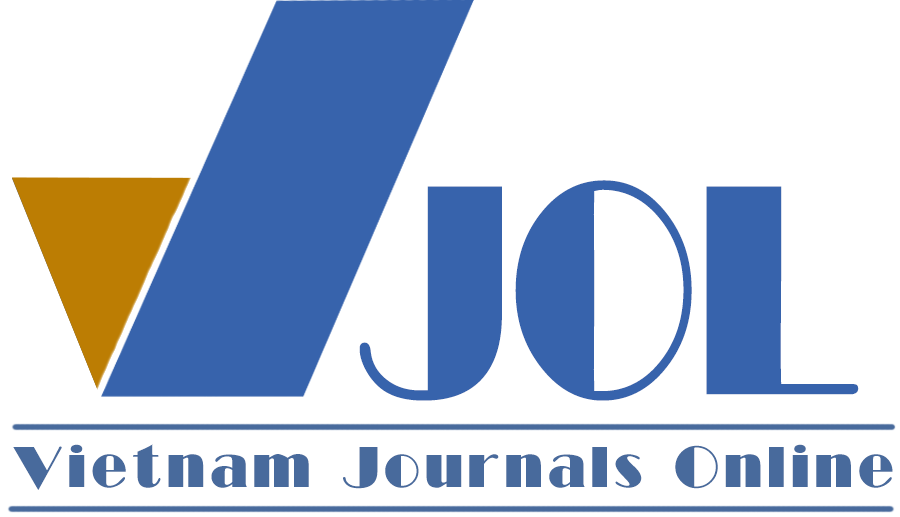Publishing process
Manuscript Submission Process
Authors must submit their manuscripts in compliance with the author policies published by the journal. The journal accepts full-text manuscripts that fully adhere to the journal's regulations (*), including:
-
Ensuring alignment with the journal’s stated mission, objectives, and scope;
-
Complying with research ethics, publication policies, and conflict of interest guidelines;
-
Following the submission rules, similarity policies, manuscript structure, formatting guidelines, page limits, and providing complete author information, clear and accurate illustrations, annotations, and standard academic English.
Authors must commit that their manuscripts are not submitted simultaneously to multiple journals and that they are original works, not previously published in any journal or other publications.
The manuscript submission process follows these steps:
Step 1: The journal receives the manuscript submitted by the author through the online submission system at hnuejs.edu.vn.
Step 2: The author receives an email confirmation upon successful submission.
Step 3: The journal’s editors conduct an initial screening to ensure the manuscript meets the stipulated regulations (*). Editors may request revisions to meet the requirements or reject the submission if it does not comply after revisions.
Step 4: The author receives a notification that the journal has accepted the manuscript for review. The journal’s official receipt date is recorded from this step.
Peer Review Process
The journal follows a double-blind peer review process through its online system, complying with the published review policies.
Each manuscript undergoes at least two rounds of peer review by two independent experts:
-
Round 1: Initial evaluation of the manuscript by the selected reviewers.
-
Round 2: Review of the revised manuscript, considering the author’s responses to the initial feedback.
If the reviewers do not require further revisions, Round 2 is omitted. If there are significant discrepancies between the two reviewers or disagreements between the reviewers and the author, a third reviewer is consulted.
The peer review process follows these steps:
Step 1: The editor consults the editorial board to select two reviewers with relevant expertise and high academic credibility for each manuscript. The reviewer list is submitted to the Editor-in-Chief for approval.
Step 2: The editor assigns the approved reviewers through the journal’s online system.
-
Reviewers and authors remain anonymous.
-
All communication occurs through the online journal system.
-
Reviewers have a maximum of 20 days for Round 1 and 10 days for Round 2.
Step 3: Reviewers submit their evaluations and recommendations via the online system.
-
Reviewers assess the manuscript on aspects such as scientific content, novelty, practical relevance, and contributions.
-
They provide specific feedback on the title, abstract, keywords, research overview, references, methodology, theoretical framework, illustrations, data, analysis, discussion, language quality, and formatting.
-
They grade the manuscript in the following categories:
-
Novelty
-
Presentation and Technical Correctness
-
Importance
-
References
-
Accuracy
-
English Quality
-
-
Ratings: A (Very Good), B (Good), C (Average), D (Poor)
-
Review conclusions:
-
Minor revisions required
-
Major revisions required
-
Rejection
-
Accept without revisions
-
Step 4: The editor, with the approval of the Editor-in-Chief, decides on the manuscript’s status based on the reviewers' evaluations:
-
Accept without revisions
-
Request revisions for Round 2
-
Reject the manuscript
-
Assign a third reviewer if necessary
Decisions are recorded in the system, and authors are notified via email. The review history is stored online for reference.
Step 5: The editor forwards revised manuscripts to Round 2 reviewers (if applicable). The review period for Round 2 is 7 days, and authors have 5 days to submit revisions.
Step 6: The editor may request further revisions after Round 2. If a third reviewer is assigned, the process follows the same two-round review format, with a total maximum review period of 30 days.
Once two reviewers approve the manuscript after revisions, it is forwarded to the editorial team for final editing.
Editing Process
The journal adheres to an online editing process, following its editorial policies.
Step 1: The assigned editor takes responsibility for the manuscript’s editorial process, liaising with the author and making necessary revision requests.
Step 2: Based on the Round 1 review results, the editor decides on the manuscript’s status:
-
Ready for final editorial approval if both reviewers accept it without further revisions.
-
Requires revisions before proceeding to Round 2.
-
Rejected if both reviewers recommend rejection.
-
Requires additional review if there are significant discrepancies between the two reviewers.
Authors have a maximum of 10 days to submit revisions for Round 1.
Step 3: Authors must revise their manuscripts according to reviewer and editor feedback. The revised manuscript is then forwarded to Round 2 reviewers.
Step 4: After Round 2, the editor makes one of the following decisions:
-
Accept without further revisions.
-
Request additional minor revisions.
-
Postpone publication if further revisions are required but cannot be completed within the journal’s deadlines.
-
Reject the manuscript if necessary corrections cannot be made.
Authors have a maximum of 5 days to submit revisions for Round 2. If a third reviewer is involved, the total revision period is 7 days.
Step 5: The editor finalizes accepted manuscripts, ensuring compliance with journal standards.
Step 6: The manuscript undergoes professional English proofreading by a subject-specific language expert.
Step 7: The editor submits the finalized proof for Editor-in-Chief approval. If further revisions are needed, the editor sends them to the author.
Step 8: Authors review the final proof before submission for printing.
Publication Approval, Printing, and Online Release
The journal follows a structured approval and publication process.
Step 1: The assigned editor submits the finalized proof and review reports to the Editor-in-Chief.
Step 2: The Editor-in-Chief makes the final publication decision, considering the reviewers’ evaluations and editorial board recommendations. The approval date is recorded as the official publication date.
Step 3: If necessary, the editor requests final author revisions before printing.
Step 4: The finalized manuscript is sent for printing, and the editor oversees the printing process.
Step 5: The digital version is published online by the journal’s designated team.
This process ensures that all submissions adhere to high academic and editorial standards, maintaining the journal’s integrity and quality.






